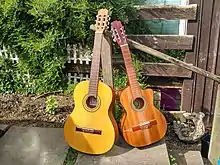Requinto guitar
A requinto guitar is a smaller version of a spanish guitar, with a scale length between 52-54cm. It is tuned a fourth higher than a standard classical guitar, to A2-D3-G3-C4-E4-A4. They often, but not always, have a cutout to reach the higher frets. It was invented and first introduced in popular music in 1945 by Mexican guitarist/vocalist Alfredo Gil of romantic music trio "Los Panchos."[1]


Use
In the 1940's, Alfredo "Güero" Gil, singer and guitarist of Los Panchos commissioned a craftsman to manufacture which is nothing more than a derivation of the spanish guitar, tuned 2 and a half tones (5 midtones) higher than the traditional tuning of the Spanish guitar, only with a smaller size at reduced scale and a slightly wider acoustic box that produces a brighter sound. Gil devised this instrument to fill the voids and spaces of silence between phrase and phrase of the songs that were sung, mostly Boleros, the genre in vogue par excellence during those years, with simple and deeply melodic lines and ornaments.

The requinto guitar is especially popular in Mexico and elsewhere in Latin America, where it is used in Trío romántico groups.
Requintos made in Mexico have a deeper body than a standard classical guitar (110 millimetres (4.3 in) as opposed to 105 millimetres (4.1 in)). Requintos made in Spain tend to be of the same depth as the standard classical.
See also
 Media related to Requinto guitars at Wikimedia Commons
Media related to Requinto guitars at Wikimedia Commons- Guitalele - A similar ukulele-guitar hybrid with the same tuning but a much smaller body.
References
- "Alfredo Gil". Lospanchos.com. Retrieved 2015-11-29.